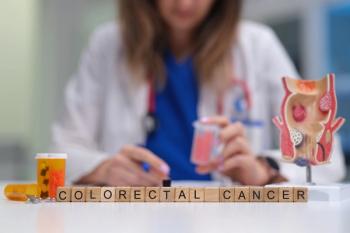
Mosunetuzumab Evokes Strong Response in Elderly Population With DLBCL
Updated outcomes from the ongoing phase 1/2 GO40554 trial show that mosunetuzumab monotherapy demonstrated promising efficacy and a tolerable safety for elderly/unfit patients with previously untreated first-line diffuse large B-cell lymphoma.
This article originally appeared on OncLive.
Updated outcomes from the ongoing phase 1/2 GO40554 trial (NCT03677154) show that mosunetuzumab monotherapy demonstrated promising efficacy and a tolerable safety for elderly/unfit patients with previously untreated first-line diffuse large B-cell lymphoma (DLBCL).1
In the 39 patients evaluable for efficacy, the overall response rate was 61.5% (n = 24), which included a 41.9% (n = 17) complete response (CR) rate. Of the 17 patients with CR, 8 (20.5%) have maintained a complete remission with a follow-up of at least 12 months from the start of therapy. The median duration of follow-up for the overall population was 9.4 months (range, 0.2–22.7).
In terms of safety, 72.9% of 48 patients in the safety cohort had at least 1 adverse event (AE) that investigators categorized as treatment related. The most common AEs were chronic rhinosinusitis (29.2%; n = 14), fatigue (18.8%; n = 9), and abdominal pain (14.6%; n = 7).
Grade 3 febrile neutropenia was observed in only 1 patient. The most common grade 3/4 AE was neutropenia (10.4%; n = 5). One patient discontinued treatment because of renal failure and disease progression and 1 grade 5 AE of sudden death due to natural causes was reported.
Elderly/unfit patients with DLBCL ineligible for standard are first-line chemoimmunotherapy because of frailty and comorbidities often receive reduced-dose rituximab (Rituxan) plus cyclophosphamide, doxorubicin, vincristine, and prednisone (R-CHOP), or therapies such as rituximab plus cyclophosphamide, vincristine sulfate, or prednisone and rituximab plus bendamustine.
R-CHOP is considered the standard of care for this patient population; however, real-world data suggest that since most elderly patients (≥ 80 years) receive an attenuated dose, it may be unsuitable because of its inferior efficacy performance.2-3
Better tolerated and more efficacious treatments are needed for this patient population, according to Adam Olszewski, MD, hematologist, oncologist, and researcher with Lifespan Cancer Institute at Rhode Island Hospital and The Miriam Hospital in Providence.
“This is a population which needs improved approaches because of the inability to deliver aggressive, full-strength chemotherapy because of their medical status or age,” said Olszewski in a presentation at the 2021 Pan Pacific Lymphoma Conference.
The multicenter GO40554 trial is currently assessing the potentially promising efficacy and manageable toxicity of mosunetuzumab, a bispecific antibody targeting both CD20 and CD3, as a monotherapy for elderly and/or unfit patients with previously untreated DLBCL considered unsuitable for standard R-CHOP therapy.
At baseline, the median age range of patients was 83 (range, 65-100); 75% of patients were 80 years or older (n = 36/48). All patients had an ECOG performance status score of 0 to 2.Of the 12 patients younger than 80 years, 5 had impaired renal function, 2 had impaired cardiac function with or without impairment in at least 1 activity of daily living (ADL) and/or instrumental ADL (IADL), and 5 had impairment in at least 1 ADL and/or IADL only.
At the data cut-off April 12, 2021, 48 patients received mosunetuzumab monotherapy. Two safety-evaluation cohorts were assessed—mosunetuzumab 13.5 mg (n = 8) and 30 mg (n = 7). An expansion cohort was added and included 33 patients treated with mosunetuzumab at the 30-mg dose.
Twenty-one patients received optional pretreatment with prednisone with or without vincristine, followed by intravenous mosunetuzumab administered in step-up doses on days 1 (1 mg), 8 (2 mg), and 15 (full dose, 13.5/30 mg) of cycle 1; the full dose of mosunetuzumab was administered on day 1 of each subsequent 21-day cycle.
Patients with a CR stopped mosunetuzumab after 8 cycles. Patients with a partial response (PR) or stable disease continued mosunetuzumab for a total of 17 cycles. The median number of mosunetuzumab cycles received was 7 (range, 0-16).
For patients in the 13.5-mg cohort, the ORR was 75%, which included a CR rate of 50% and a PR rate of 25%. In the 30-mg cohort, the ORR was 58.1%, comprising a 41.9% CR rate and 16.1% PR rate. Follow-up for patients in the expansion cohort was limited.
Chronic rhinosinusitis was grade 1 or grade 2 and occurred only during cycle 1 of mosunetuzumab. The most frequent chronic rhinosinusitis effects were pyrexia (78.6%; n = 11/14) and chills (42.9%; n = 6/14). Grade 2 chronic rhinosinusitis events (n = 4/14) were treated with supportive care in all patients and steroids in all patients and steroids in 1 patient. No pressors or tocilizumab were used, and no treatment in the intensive care unit was required.
Pharmacodynamic changes in peripheral blood in cycle 1, including T-cell activation and cytokine production, were similar between elderly/unfit patients with previously untreated DLBCL who received mosunetuzumab monotherapy in the current study and fit patients with previously untreated DLBCL who received mosunetuzumab-CHOP in an ongoing phase 1b/2 trial (NCT03677141).
Olszewski concluded that mosunetuzumab monotherapy should be further evaluated as a chemotherapy-free backbone for patients unable to tolerate standard chemoimmunotherapy.
“These data suggest a potential future role for mosunetuzumab, as monotherapy or in chemotherapy-free or chemotherapy-light combinations, in older and/or unfit patients with previously untreated DLBCL who are considered unsuitable for standard R-CHOP therapy,” Olszewski wrote in a poster of the data presented.
Biomarker analyses are ongoing.
References
- Olszewski A, Avigdor A, Babu S, et al. Mosunetuzumab (Mosun) monotherapy for elderly/unfit patients (pts) with first-line diffuse large B-cell lymphoma (DLBCL) continues to show promising safety and efficacy with durable complete responses. Presented at: 2021 Pan Pacific Lymphoma Conference; August 9-13, 2021; Big Island, HI.
- Tilly H, Gomes da Silva M, Vitolo U, ESMO Guidelines Committee, et al. Diffuse large B-cell lymphoma (DLBCL): ESMO Clinical Practice Guidelines for diagnosis, treatment and follow-up. Ann Oncol. 2015;26(suppl 5):116-125. doi:10.1093/annonc/mdv304
- Shewade A, Olszewski AJ, Pace N, et al. Unmet medical need among patients with previously untreated DLBCL characterized using real-world data in the United States. Blood. 2020;136(suppl 1):6-8. doi:10.1182/blood-2020-136271
Newsletter
Pharmacy practice is always changing. Stay ahead of the curve with the Drug Topics newsletter and get the latest drug information, industry trends, and patient care tips.











































































































































































































